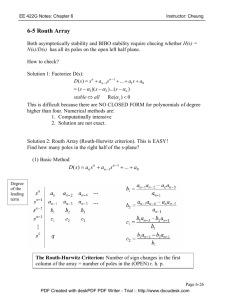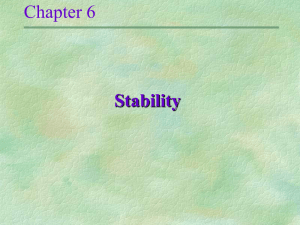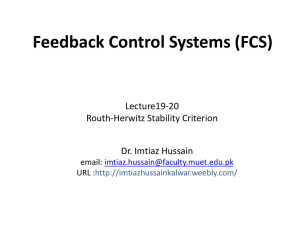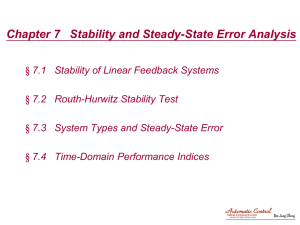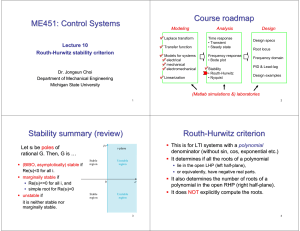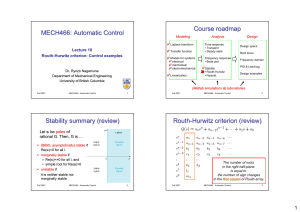Routh Hurwitz Stability Criterion
advertisement
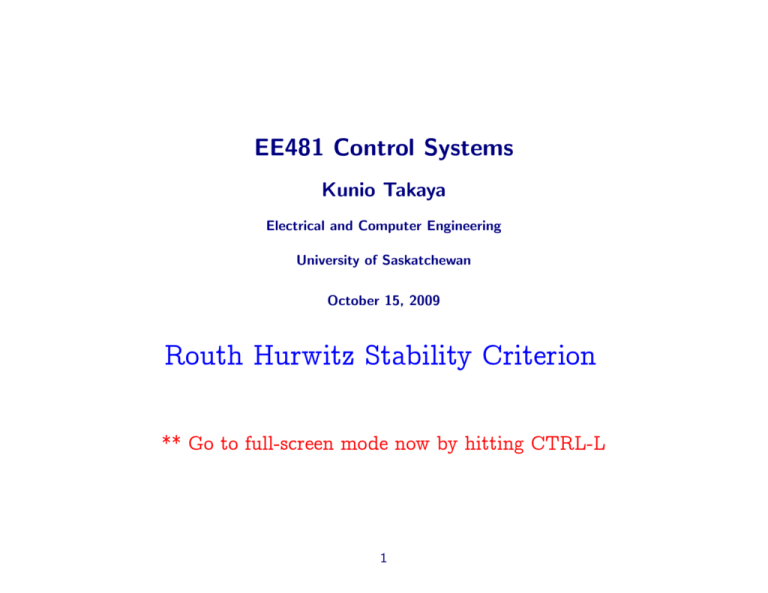
EE481 Control Systems Kunio Takaya Electrical and Computer Engineering University of Saskatchewan October 15, 2009 Routh Hurwitz Stability Criterion ** Go to full-screen mode now by hitting CTRL-L 1 University of Saskatchewan, Electrical Engineering EE 481.3 Control Systems April 2009, Kunio Takaya Textbook: Norman S. Nise, “Control Systems Engineering” Fifth Edition, John Wiley & Sons, Inc. 2008, ISBN-13 978-0471-79475-2. Marks: Midterm Exam: 30%, Final Exam 55%, and Assignments 15% 1. Modeling in the frequency domain • Laplace transform • Transfer functions 2. Modeling in the time domain 2 • Linear differential equations • State-Space representation 3. Time response • Second-Order Systems • Poles and zeros • Time domain solution of state equations 4. Reduction of multiple subsystems • Block diagrams and Signal-Flow graphs • Mason’s rule • Similarity transformations 5. Stability • Routh-Hurwitz criterion • Stability in State-Space 3 6. Steady-State errors • Steady-State error for unity gain feedback • Steady-State error for disturbance 7. Root Locus techniques • Sketching the root locus • Transient response design via gain adjustment 8. Design via root locus • Cascade compensation • Improving transient response and steady-state error 9. Frequency response techniques • Bode plots • Nyquist diagrams • Systems with time delay 4 10. Design via frequency response • Lag compasation • Lead compensation Classes: MWF 8:30-9:30 a.m. 2B01 Engineering My office: 3B31 Email: kunio.takaya@usask.ca 5 1 Stability The response of control systems consists of (1) natural response and forced response, or (2) zero input response and zero state response. For natural (zero input) response, a system is, 1. stable if the natural response approaches zero as time approaches infinity. 2. unstable if the natural response approaches infinity as time approaches infinity. 3. marginally stable if the natural response neither decays nor grows but remians constant or oscillates. 6 For the total response, a system is 1. stable if every bounded input yields a bounded output. 2. unstable if any bounded input yields an unbounded output. 7 8 2 The Routh Hurwitz Stability Criterion The Routh Hurwitz stability criterion is a tool to judge the stability of a closed loop system without solving for the poles of the closed loop system. 9 Generating a Routh-Hurwitz table 10 11 Example 6.1 12 Any row of the Routh table may be multiplied by a positive number. 13 Interpreting the basic Routh table The number of roots of the polynomial that are in the right half plane is equal to the number of sign changes in the first column. In Example 6.1, s3 1 31 0 s2 1 103 0 s1 −72 0 0 s0 103 0 0 There are two sign changes in the first column. 1 =⇒ −72 and − 72 =⇒ 103 Therefore, two of the four roots of s3 + 10s2 + 31s + 1030 = 0 are in the right half plane of s-plane. 14 Special case 1: Zero in the first column T (s) = 10 s5 + 2s4 + 3s3 + 6s2 + 5s + 3 When zero is resulted in the first column, replace 0 with a small . 15 Examine the first column by assuming is a either positive or negative number. Since there are two sign changes, the polynomial has two poles in the right half plane. 16 Special case 2: An entire row is zero. T (s) = 10 s5 + 7s4 + 6s3 + 42s2 + 8s + 56 The row if s3 is entirely zero. Let the polynomial above (row of s4 ) be P (s). Then, differentiate P (s). P (s) = s4 + 6s2 + 8 17 dP (s) ds = 4s3 + 12 Then, replace the row of s3 with the coefficients of dP (s)/ds. Then, proceed normally. There are no sign changes, so the system T (s) is not unstable. 18 More about the case of entire row is zero. 1. The row previous to the row of zeros contain the even polynomial that is a factor of the original polynomial. s4 + 6s2 + 8 = 0, in the example above. 2. The root to find is with respect to s2 , so s2 = a yields √ s = ± a. Therefore, the roots are symmetric about the imaginary axis. If s is complex, s = σ + jω, its complex conjugate is also a root, meaning symmetric about the real axis (because the original polynominal is of real coefficients.) 3. Everything from the row containing the even polynomial down to the end of the Routh table is a test of only the even polynomial. In the above example, s4 + 6s2 + 8 = 0 has no roots in RHP. Then, all has to be on the imaginary axis. √ 4 2 2 2 s + 6s + 8 = (s + 2)(s + 4) = 0 ⇒ s = ±j 2, and ± j2. 19 The above example has one root in LHP, and four roots on the imaginary axis (marginally stable). 20 Special case 2: One more example 20 T (s) = 8 s + s7 + 12s6 + 22s5 + 39s4 + 59s3 + 48s2 + 38s + 20 21 22 Stability Design for Feedback Systems G(s) K T (s) = = 3 1 + G(s) s + 18s2 + 77s + K 23 • If K > 1386, s1 term is negative. Hence, two poles are in the right half plane (unstable). • If K < 1386, there are no sign changes. Hence, the feedback system is stable. • If K = 1386, the row of s1 is zero. By replacing with the coefficients of the dP (s)/ds, there are no sign changes. The system T (s) is, however, marginally stable. 24 Stability of a State Equation Conversion from a state equation to a transfer function The vector/matrix form of the state equation and output equation for single input and single output is, ẋ = Ax + bu y = cx + du Take the Laplace transform, sX(s) − x(0) = AX(s) + bU (s) Y (s) = cX(s) + dU (s) 25 Transfer function assumes x(0) = 0. sX(s) − x(0) = AX(s) + bU (s) Y (s) = cX(s) + dU (s) sX(s) − AX(s) = (sI − A)X(s) = bU (s) X(s) = (sI − A)−1 bU (s) Y (s) = cX(s) + dU (s) = c(sI − A)−1 bU (s) + dU (s) = [c(sI − A)−1 b + d] U (s) Therefore, Y (s) U (s) = c(sI − A)−1 b + d 26 = = c(sI − A)−1 b, if d = 0 c adj(sI − A) b det(sI − A) Since (sI − A)−1 = The poles of the system adj(sI − A) det(sI − A) Y (s) are, therefore, U (s) det(sI − A) = jsI − Aj = 0 which is the eigen values of A. 27 Example: Apply Routh-Hurwitz stability criterion. ẋ = 0 2 −10 3 1 10 8 1 x + 0 u(t) −5 −2 0 y = [1 0 0] x 1 0 sI−A = s 0 1 0 0 0 0 0 − 2 1 −10 3 1 s −3 8 1 = −2 s − 8 −5 −2 10 5 det(sI − A) = s3 − 6s2 − 7s − 52 28 −1 −1 s+2 The Routh table is, s3 1 s2 −3 s1 −1 0 0 s0 −26 0 0 −7 0 −26 0 Since there is one sign change, one of three poles is in the right half plane (unstable). 29
